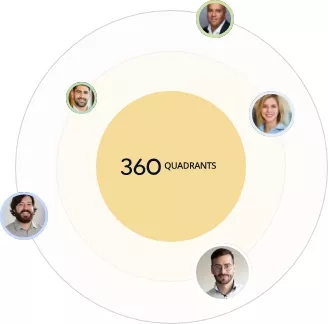Laboratory informatics is the application of information technology to scientific processes and the management of electronic records to optimize and extend laboratory operations. It encompasses data acquisition, lab automation, instrument interfacing, laboratory networking, data processing, specialized data management systems, laboratory information management systems, scientific data management systems (including data mining and data warehousing), and knowledge management (including the use of electronic laboratory notebooks), among others.
The Laboratory Informatics Market vendors are placed into 4 categories based on their performance and reviews in each criterion: “visionary leaders,” “innovators,” “dynamic differentiators,” and “emerging companies".
Visionary leaders include players that have an established product portfolio coupled with a strong geographic market presence. These companies offer technologically advanced lab informatics solutions and also focus on maintaining and upgrading them. The above-mentioned companies are also known for their well-established geographical presence and widespread distribution network. These companies are known to adopt strong business strategies in order to increase their foothold in the market.
Dynamic players are established vendors with very strong business strategies and market presence. However, their product portfolio may not be as vast as the vanguards. They generally offer specialized products.
Innovators demonstrate substantial product innovations in comparison to its competitors. They focus on product portfolios but do not have very strong growth strategies for the overall business, and often have a limited geographical presence. They also show considerable investments in research and development activities in comparison to their competitors.
Emerging vendors have niche product offerings, and they also do not have strong business strategies in comparison to other business vendors. They may be new entrants in the market and would require more time before gaining significant traction. Emerging companies usually do not have a wide market presence. North America, which comprises the US and Canada, is the largest market for laboratory informatics. This segment accounted for the largest share of the laboratory informatics market. A large share of the North American market can primarily be attributed to the strong economies in the US and Canada, which have allowed for significant investments in new technologies. Growth in the North American market is also supported by the growing demand for the integration of laboratory systems, rising government funding for research, growth in biobanks, need for early drug discovery, easy availability of laboratory informatics products and services, and stringent regulatory requirements across industries. Europe accounted for the second largest share of the laboratory informatics market. The European market for laboratory informatics is estimated to grow at a steady pace during the forecast period. Technologically advanced countries such as Germany, the UK, and France are the major contributors to the laboratory informatics market in Europe. Over the last decade, Asia has become a major hub for R&D activities. With the increasingly competitive global scenario and rising foreign direct investments by North American and European pharmaceutical and biotechnology firms in Asia, it is expected that the adoption of laboratory informatics solutions in this region will increase significantly. The development of supporting infrastructure in research laboratories in countries such as Singapore and India is also expected to support the growth of this market during the forecast period.



